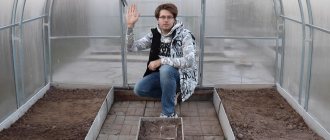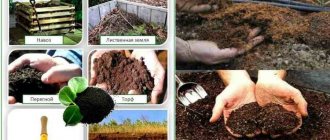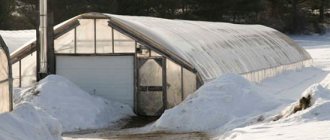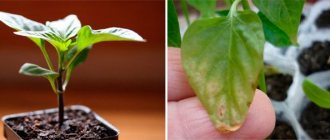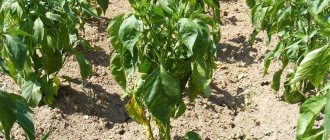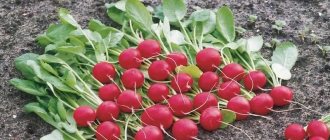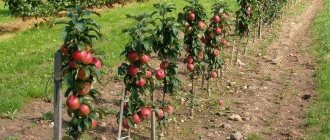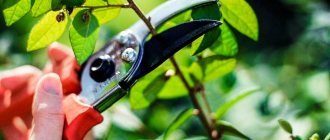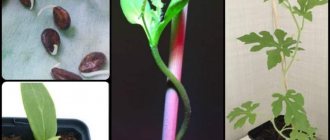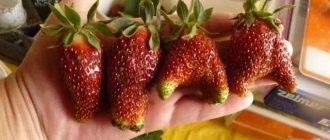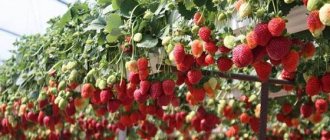There is probably not a single amateur garden where an apple tree does not grow. It is the most popular seed crop in world gardening. And in our country it can rightfully be considered a symbol of the domestic orchard, since it was grown here back in the days of Ancient Rus'.
Not a single royal feast was complete without sparkling apple wine (analogous to modern “Cider”), pies with apple filling, roast goose with apples, pickled and pickled apples with cabbage! All these dishes were considered mandatory at any feast!
The selection of large-fruited apple tree varieties began under Peter I, who banned the import of imported apples into the country. It was during his reign that more than thirty domestic varieties were developed.
Many foreign guests were surprised at the number of types and varieties of apple trees in Rus'. Such diversity could not be found in any European country. It was for this reason that foreigners secretly called Russia the “Apple Tree Kingdom.”
Since the apple tree is a crop well known to modern gardeners, they are confident that they know everything about it: how to plant, how to care for it. However, this common misconception sometimes leads to sad consequences (lack of fruiting, various diseases and even plant death).
In this article we will talk about how to properly grow a healthy, strong apple tree that annually produces high yields of large, tasty fruits and will suggest the most interesting modern and popular varieties for planting on your site.
Recommended timing
The timing of planting apple tree seedlings is determined by climatic features and weather conditions of a particular region. When to plant apple trees - in spring or autumn, we will consider further.
Advantages of spring and autumn planting
Spring planting of apple trees is preferable for areas with cold winters, since the seedlings have enough time to take root before the onset of cold weather. As a rule, events are held from late April to mid-May ; during this period the possibility of return frosts is excluded.
Important! The main disadvantage of spring planting is the waste of energy on the formation of green mass, so such seedlings need maximum attention: strict adherence to the watering regime and loosening the soil.
Planting young apple trees in the fall is recommended only in the south of the country, where the soil does not freeze in winter; the appropriate time for the procedure is from the end of September to the first ten days of October . At this time, all the forces of the culture are aimed only at rooting, so the seedling does not require intensive care (as in the summer).
In summer such events are extremely rare. This may be a spontaneous transplant caused by one reason or another, or the planting of very high-quality bare-root planting material. At such times, it is important to provide intensive watering and the necessary fertilizing.
Suitable time for different regions
When planting apple tree seedlings, it is recommended to follow the following table:
| Region | Climate specifics | Planting dates in autumn | Planting dates in spring |
| Northwestern, including Leningrad region. | Long spring, early autumn | During October | End of April – first ten days of May |
| Moscow region, Central and Volga region, Mordovia | Spring with frequent frosts, relatively warm autumn | Late September – mid October | End of April – beginning of May |
| South of the Russian Federation, including Rostov region | Very warm spring, long autumn | Mid-October – first ten days of November | Throughout April |
| Siberia | Late spring, short autumn | First half of October | First half of May |
| Ural | Spring with frequent frosts | Second half of September | First half of May |
Important! In the south of Russia, it is permissible to plant apple tree seedlings in winter (December), which is due to the warm climate with temperatures above 0°.
Treatment against diseases and pests
Chemical and biological protection against diseases and various harmful insects is one of the three important components in the question of how to care for a young apple tree.
Chemical protection of the garden should be carried out only as a destructive measure and in no case should it be used “for the sake of prevention.”
Because “chemistry” is equally dangerous for both harmful and beneficial insects, but the harmful ones, having become accustomed to the poison, multiply to incredible volumes, while the beneficial insects recover much more slowly.
Annual protection plan
Time until leaves bloom:
- Collecting and burning dry apples from branches;
- Treatment of bark with a solution of washing soda in case of an outbreak of bark beetles or treatment of twigs and branches with a solution of urea (25%) against fungal spores.
When young leaves appear:
- To prevent scab and rot, apple trees are treated with Bordeaux or HOM;
- When weevils fly, they are shaken off the branches onto bedding polyethylene in the evening or at dawn, followed by their extermination.
Flower appearance period:
- When affected by the flower beetle, more than half of the examined apple tree flowers are treated with Decis and Aktara according to the instructions;
- Diseases are treated either by using SCOR (according to instructions) or by using Bordeaux mixture when spraying apple trees;
- Ticks are destroyed with the drug “Antiklesch” or “Aktelik”;
- Gnawing and sucking are destroyed by the drugs “Dendrobacillin”, “Akarin (Agravertin)”, “Entobacterin” - these are safer drugs.
- But if the outbreak of harmful insects is large, then the insecticides Imidacloprid (200 mg-600 mg), Thiamethoxam (200 mg) are used; Chlorantraniliprole (100 mg). But carefully and only after the apple trees have bloomed! The solution is prepared strictly according to the instructions, using 2 liters per apple tree.
After flowering:
hunting belts on the trunks of apple trees . In the south they are inspected every 8 days, and in the northern regions once a month. If there is a cluster of pests, they are burned. 15 days after flowering.
Hunting belts.
In damp summers, treat apple trees with Fitosporin and Alirin-B, or Gamair and Glyokladin, but if the disease progresses, then use Quadris, Maxim and Discor.
A month after flowering.
If necessary, spray the garden against codling moth caterpillars, moths with Alpha-cypermethrin and Pirinex, but strictly according to the instructions!
18 days after the previous treatment.
If necessary, apple trees are sprayed a second time against codling moths, leaf rollers, itches, aphids and rots.
Repeat after 17 days, only when the third generation of the moth appears in the garden, and do not treat without its strong flight.
Early autumn time period before frost appears.
Treatment of the garden from wintering diseases and pests is whitewashing with copper sulfate, treatment with urea and removal of rotten carrion.
Variety selection
When choosing a variety for cultivation, you need to take into account such characteristics as fruiting and ripening periods, taste qualities.
There are 3 main categories of apple tree varieties:
- winter - the advantage is the possibility of long-term storage while maintaining all quality characteristics, the most common of them are: Antonovka vulgaris, Lobo, Bogatyr;
- summer - ripen in July August, the most popular: Grushovka, Krasnoe early, White filling, Melba;
- autumn - they bring the harvest in September-October; common among gardeners are: Pervinka, Zhigulevskoe, Orlovskoe striped.
Rules for selecting seedlings
When purchasing planting material, take into account the following:
- Variety – it is recommended to give preference to varieties suitable for cultivation in a particular area.
- Ripening period - middle and late periods are well suited for long-term storage and canning, early periods are good for fresh consumption.
- Age – the most suitable specimens are those under the age of 2 years, which have at least 3 side shoots. It is not advisable to use a seedling grown from a seed for planting.
- Size – optimal trunk thickness: from 1 to 2 cm, height – up to 1.5 m;
- Quality – there are no damaged or rotten fragments on the bark and root system. The grafting site is located above the root collar at a distance of 10-15 cm and is clearly visible.
Important! Purchasing seedlings with awakened buds is permissible only if they are planned to be immediately planted in open ground.
Growing apple trees from seeds (seeds) is a rather labor-intensive process; in this case, the appearance of the first harvest should be expected no earlier than 5-10 years from the moment of planting.
How to take seedlings from an apple tree: practical advice
You can take a seedling from an apple tree yourself. You don’t have to be an experienced gardener to do this.
If you want to get a varietal apple tree , then you can use the parent shoot, which sometimes you just need to dig in correctly.
The procedure is carried out in the spring . You can use young shoots no more than 1 year old.
They are placed in a hole about 10 cm deep. The branch is attached to a peg. Thus, a shoot of 30–40 cm should remain above the ground . It needs to be watered regularly and the nearby area must be kept free of weeds.
To be sure, root several branches in this way. In a year, some of them will take root. In the fall, the seedlings will be ready for transplanting.
IMPORTANT! Remember that large-fruited apple trees root worse in this way than other varieties.
Suitable location on the site
Where to plant an apple tree on the site? The right location determines the growing conditions that affect the health of the plant, life expectancy and productivity.
Basic requirements for a place to plant an apple tree:
- good lighting;
- air circulation;
- absence of drafts;
- protection from winds.
Planting in partial shade can cause low yields and stretch apple trees in height. In addition, such conditions contribute to the formation of dampness, which stimulates the development of various diseases.
Wetlands and places with close groundwater (less than 2 m) are not suitable The ideal option would be a place located on a southern, southwestern or southeastern slope.
Soil Features
Full growth and fruiting of an apple tree is possible only in soil with the following characteristics:
- porosity and looseness of the structure;
- the ability to absorb moisture well and retain it for a long time;
- acidity pH 5.1-7.5;
- absence of salinity, as well as chloride and sulfate salinity;
- total carbonate content – up to 15%.
Sandy loam, loamy and chernozem soils meet these requirements.
Apple tree planting scheme
Apple trees are planted as single trees or in groups, taking into account the distance from each seedling to household buildings and nearest neighbors. For low-growing varieties characterized by a small crown, this interval should be at least 4 m .
The planting of an apple orchard is carried out according to a certain scheme, depending on the varieties of fruit crops. According to experts, it is best to do this in rows in a checkerboard pattern, observing the distance rules (the distance between apple trees when planting):
- for tall varieties with a massive crown - 6-7 m ;
- for columnar ones - 1-1.5 m .
Important! Sufficient spacing between apple trees reduces the risk of disease and pest damage.
Apple tree planting distance from the fence
The distance between planted trees and neighboring fences is regulated by the charters of gardening cooperatives and partnerships or local authorities. Typically this indicator depends on the crop variety:
- for tall varieties of apple trees, the distance to the fence is from 4 m;
- for short people – from 2 m.
Planting seedlings in place of old apple trees
It is unacceptable to plant young trees where old crops grow .
This is due to the depletion of the soil and the accumulation in it of an excess of specific inhibitors secreted by the root system of the old apple tree. In addition, such areas are affected by harmful microorganisms and insects.
Desirable and Undesirable Neighbors
Provided the correct planting pattern is followed, many types of garden crops can be grown near a fruit tree. What you can plant an apple tree next to, and what plants next to it is not recommended, is indicated in the table.
| Suitable neighbors for the apple tree | Unwanted neighbors of the apple tree |
|
|
Types of Apple Orchards
There are several types of apple orchards, which differ from each other.
By rootstock and vigor:
- vigorous (height more than 3.5 m);
- medium-sized or semi-dwarf (2.5–3.5 m high);
- low-growing or dwarf (1.5–2.5 m high).
Intensive apple orchard
According to yield, duration of operating period and level of profitability, all gardens are divided into:
- extensive, or classic (service life - up to 35 years);
- semi-intensive (service life - up to 25 years);
- intensive (service life – up to 15–20 years);
- super-intensive (service life – up to 10–15 years).
Preparing the planting hole
It is recommended to prepare the hole for autumn planting of an apple tree no later than 3-4 weeks before the procedure. Spring planting also means preparing the hole in the fall. This process consists of several steps:
- formation of a hole 60-70 cm deep and the same diameter;
- combining the soil removed during digging with fertilizers and placing it at the bottom of the hole.
Important! To obtain a fertile composition, the soil from one hole is mixed in equal parts with peat and humus, and 1/2 a bucket of wood ash and 300 g of superphosphate are added.
Features of planting in different types of soil
Since sandstones do not hold water and are not rich in nutrients, it is recommended to create pits as large as possible in this type of soil. In the future, the planted apple trees will need frequent feeding.
To plant apple trees in clay soils, you need holes the same size as for sandstones. In this case, the diameter should be about 150 cm, and the depth should be approximately 70 cm. The resulting hole is lined with a drainage layer: expanded clay, broken brick or crushed stone. To prepare the nutrient mixture, up to 25% of coarse-grained river sand is added to the usual recipe; this solution will provide the soil with a looser structure.
Sequence of planting apple tree seedlings in rocky soil :
- Preparing a hole with a depth of 60-70 cm and the same diameter (a larger size is acceptable).
- Formation of two trenches perpendicular to each other with a length and depth of up to 40 cm, passing through the center of the pit.
- Place the nutrient mixture into the well.
- Production of vertical fascines from rods with a length of 40 cm and a diameter of 3 cm.
- Installation of fascines along 4 trench arms so that the distance between them and the center of the pit is at least 60 cm.
- Planting a seedling.
Processing and whitewashing of trunks
In all types of young apple orchards, not only the trunks are whitened, but also the branches that form the base of the tree.
The most suitable period for whitewashing will be from February 21 to March 31 . And the further south the garden is located, the earlier it is whitewashed. This will protect the young, rough bark of apple trees from “sunburn” and from frost damage caused by a sharp change in temperature.
For the whitewashing itself, you can use carbide, quicklime and fluff lime.
VERY IMPORTANT! Under no circumstances use bleach and compositions ready for work in damp areas!!! This is dangerous for apple trees!
Whitewash recipe: In 8 liters of water poured into a 10 liter plastic bucket, dissolve 2 kg of fluff, 1 kg of fatty clay, 1 glass of skim milk, 10 grams of wood glue or 30 grams of office glue, or one cake of fresh mullein.
Having prepared whitewash without glue, you will need to whitewash the entire garden after the first serious rain!
In the video, watch the expert’s opinion - why whitewashing of apple trees is necessary:
Late whitewashing of apple trees before the holidays in May will only decorate the garden, without really helping the apple trees. As well as whitewashing very old tree bark that is older than 20 years.
They whitewash with poplar , trying to coat everything thoroughly. If there are a large number of apple trees, whitewashing is mechanized.
If for some reason whitewashing is impossible, then tying the branches and trunks of apple trees with old agrofibre, matting, corn sheaves (corn shoots left in the field for the winter) or spruce branches will also help the apple trees “not get burned” in the sun.
Read more about whitewashing apple tree trunks here.
Preparing seedlings - how to increase survival rate
To speed up the adaptation of planted apple seedlings, it is important to provide them with proper care. There are several secrets.
Root pruning
Plants purchased with an open root system need to be trimmed, removing damaged fragments to a living area. The operation is performed with a sharply sharpened knife, and after it is completed, the resulting wound is treated with ash.
Apple tree seedlings with closed roots do not require such a procedure, since they are transplanted using the transshipment method while preserving the earthen clod.
Trimming the above-ground part
The height of the trunk is shortened to 7 buds, the side branches (if any) are reduced by 1/3. This operation helps to slow down the development of the seedling, which allows it to redirect its forces to rooting.
Important! Planting material purchased from a nursery cannot be pruned.
Soaking the root system
To accelerate growth, the roots of apple tree seedlings are soaked in a special solution for 2-4 hours.
Typically, Epin is used for this purpose, diluted with water in a ratio of 2 ml / 5 l. This procedure is advisable regardless of the time of planting. When planting specimens with a closed root system using the transshipment method, the soil is irrigated with a solution to accelerate growth after the procedure is completed.
Recommended planting depth for apple trees
The depth of the dug hole varies from 60 to 90 cm. For growing in fertile soil, a hole corresponding to the size of the root system will be quite sufficient.
Watering rules
After planting, up to 30 liters of water are poured into the planting hole. After the hole sags as it is absorbed, soil is added to it.
During the process of crop adaptation, seedlings are watered once every 10 days, taking into account weather conditions.
Mulching the tree trunk circle
A poured layer of mulch allows you to retain moisture in the tree trunk and protect the young tree from pests. In summer its thickness should be 5 cm, in winter – 10 cm.
The following is usually used as mulch for apple trees:
- rotted manure;
- compost;
- peat mixed with sawdust and sand;
- grass
Reasons for possible death of seedlings
The main reason for the death of planted planting material is the close occurrence of groundwater. Planting on a hill can prevent this problem.
Graft
This is one of the ways to propagate a plant, get a new variety, or increase the frost resistance of a southern variety when grown in harsh climatic conditions, if you graft a varietal cutting onto the rootstock of a zoned variety or wildflower. You can also make a garden tree, where each branch brings different apples, or even pears and apples. It is quite possible to do this with the help of vaccination. There are several methods, each of which gives good results. Having the necessary tools for the job (sharp knife, polyethylene or electrical tape, garden pitch), you can also experiment.
Budding or grafting with a bud is a “summer option.” It’s easy to know if the time has come. The bark comes off the wood very easily if you pry it a little with a knife.
Instructions:
- For grafting, take a rootstock with even and smooth bark. The shoot thickness must be at least 1 cm.
- A well-ripened one-year-old branch from an absolutely healthy plant, 25–30 cm long with developed leaves, is suitable for the cutting. The shoot is cut off, the leaves are torn off (leaving part of the petiole). The top of the shoot with unripe buds is removed.
- If the grafting is done immediately, then the cutting is placed in a glass of water while the rootstock is being prepared. If the work is planned in a few days, then the prepared branch is wrapped in a damp cloth and placed in the refrigerator. You need to make sure that the bundle does not dry out.
- All side shoots are removed from the rootstock and a T-shaped incision is made into the bark at a height of 20 cm (horizontally about 1 cm, vertically about 3 cm). Carefully bend the incision site, creating a small “pocket”.
- The bark along with the bud is cut from the cuttings. The length of the resulting shield is about three centimeters.
- The kidney is placed in a T-shaped incision and tightly wrapped with plastic film. The turns go from top to bottom.
- After about two weeks, the result is checked. If the bud has taken root, then a piece of the remaining leaf petiole has already fallen off or falls off with a light touch.
Butt budding is a simple and quick method of tree grafting that can be used even in unfavorable conditions
Copulation means that the rootstock and scion are of the same thickness. Typically, one-year, well-ripened growth is used for this purpose.
Copulation can be used at any time of the year, the method is extremely simple: make an oblique cut on the shoots, combine, fix
Make an oblique cut on both branches with a sharp knife, carefully combine them and wrap them tightly with tape. This vaccination can be done at any time of the year, and the winter one gives a higher survival rate than the summer one. For better fusion, the entire procedure must be done quickly, in a minute. If more time passes, the sections will have time to dry out and the graft will not take root. Doing everything quickly requires skill.
To make their work easier, they do a “honey vaccination”.
Instructions:
- Add a teaspoon of honey to a glass of water and place the cuttings in it immediately after cutting. They can stand in this solution for up to three hours.
- After this, the cut is not renewed or wiped, but is immediately combined with the rootstock and tightly wrapped with tape. This method allows you to prepare cuttings in advance.
- In addition, the honey solution serves as an indicator. If after 10–15 minutes of being in it the cutting turns brown, this means that it is frozen and is not suitable for grafting. Since ancient times, the bactericidal properties of honey have been known; the fusion of rootstock and scion occurs better with its help.
Grafting into a cleft allows the use of a rootstock that is thicker (2 times) than a scion.
Grafting into clefts is a simple, convenient and universal method, suitable for most types of fruit trees, has a high survival rate
Instructions:
- The rootstock is cut horizontally.
- A split 4–5 cm deep is made exactly in the center.
- The lower edge of the cutting (or cuttings) is sharpened on both sides and inserted into the rootstock.
- Everything is tied tightly with tape, and the cut is covered with garden varnish.
Grafting behind the bark allows you to use from 3 to 5 cuttings, it all depends on the thickness of the rootstock. This method is used in the spring, during active sap flow, to regraft a tree.
The bark grafting method allows the use of up to five cuttings and is highly effective
Instructions:
- The cuttings are cut obliquely (about 3 cm) on one side and inserted into cuts in the bark on the stump.
- Everything is securely fixed and covered with garden varnish.
- The top of the cutting is cut off above the bud; its height above the stump is no more than 3–4 cm.
Video: the best ways to graft fruit trees
Proper planting of apple trees - step-by-step instructions
Successful adaptation of seedlings is determined by their proper planting in compliance with all rules of agricultural technology. How to properly plant apple tree seedlings in spring and autumn, with ZKS and cuttings - we will consider further.
With closed root system
Apple tree seedlings with a closed root system are grown in containers (plastic pots with a volume of 0.5 to 50 liters) and sold without digging them up. The advantage of such planting material is as follows:
- ability to take root well at any time of the year: from April to October;
- no problems during transportation and storage before planting in open ground.
When planting, it is important to follow several rules:
- preservation of the integrity of the earthen coma and its abundant moisture the day before planting;
- careful removal from the container to avoid damage to small roots.
Planting in autumn
When planting at this time, the hole is prepared approximately 1 month before the procedure to allow the soil to settle. The activity is carried out after leaf fall, so that all the seedling’s energy goes only to the formation of roots.
The sequence of the procedure for autumn planting an apple tree:
- form a hole with a depth corresponding to the length of the roots;
- drive a stake in the middle;
- lower the roots of the seedling into the hole and carefully straighten it;
- cover with prepared fertile soil so as to leave the root collar above the surface;
- compact the soil and then moisten it abundantly;
- tie the tree to a support;
- After the soil settles, add the missing part.
Important! When planting apple tree seedlings in the fall, fertilizing is not recommended, as this may provoke bud growth before the onset of cold weather.
Features of planting in spring
Spring planting of apple trees is carried out according to the standard algorithm, but when the seedling is buried, some type of complex fertilizer is added to the soil. Usually, for this purpose, gardeners use “Fruit. Spring”, “Universal Ideal” and others.
Cuttings
In March-April, the prepared planting material of the cuttings is placed in a container with water, always rain or melt water. Activated carbon tablets are first dissolved in the liquid.
After about 20 days, a kind of thickening forms on the cuttings and the formation of the root system begins. When the roots reach 6 cm, they are planted in open ground.
Important! For the first time after planting apple tree cuttings, it is recommended to set up a greenhouse using film, as well as a glass or cut plastic container.
Digging and tillage
Digging or hoeing in the garden is done only when the soil is completely ready (“ripe”). This is prohibited when the earth “smears” the shovel (when digging, the earth does not loosen, but sticks to the tool). The parched soil is dusty.
, humus is scattered under the trees as early as possible
When digging up soil in the garden in the autumn, the depth of cultivation should be as small as possible so as not to damage the roots of apple trees.
In the near-trunk areas, the soil is cultivated to a depth of 6-8 cm near the trunk and 11-14 cm at the end of the near-trunk zone; between rows it can be loosened to a depth of a quarter meter.
A shovel, preferably an “American” one, stands with its edge to the trunk when digging, and loosening proceeds in a circle, like a snail, with increasing digging depth, so as not to damage the main roots.
Digging the soil around the apple tree.
ADVICE: During the winter, it is better not to crush the soil when digging in the garden , but to keep it lumpy, with a hilly surface; this will supply the soil with moisture, and the overwintering stages of pests will die over the winter. But in areas with high wind erosion, they dig up once every 5 years and only in the spring! The rest of the time they dig with forged pitchforks, and in strong winds they dig with them, only loosening the soil layer without turning it over.
Caring for young apple trees after planting
Rules for caring for planted fruit seedlings include the following:
- timely and competent watering, in the fall the procedure is carried out 14 days before the onset of the first frost;
- loosening the soil;
- weeding and getting rid of weeds;
- shelter for the winter using burlap or special material;
- pruning and crown formation: shortening the main shoots by 1/3, and completely removing damaged fragments.
be fed 3 years after planting (in spring), using organic and mineral preparations, as well as mixtures prepared independently.
Prevention of diseases and pests
In order to ensure protection of apple trees from pests and various diseases, seedlings are treated with special preparations: chemical or biological against mites, aphids, fungi (Aktara, Karate, Pirimor, etc.).
To prevent the negative effects of low temperatures, the 7 cm circle around the trunk is filled with humus or peat.
Mulching and sodding
Mulching apple trees grown using the “black fallow” or steam-green manure system:
- Significantly smoothes out temperature fluctuations during hot periods in the layer inhabited by suction roots;
- Promotes the accumulation of vermicompost ;
- And the reproduction and prosperity of beneficial soil biota;
- Allows less water to evaporate;
- Do not form a dense crust on the soil after watering or rain.
Apple trees are mulched with rotted manure, garden compost, mass after breeding earthworms, former mushroom blocks, seed husks, flax tows, and lowland peat.
IMPORTANT! The use of chaff, sawdust and shavings, straw and straw cuttings, high-moor peat, bark from stripping coniferous trunks or spruce branches is strictly prohibited!
Where apple trees grow, you can sow leaf mustard, oilseed radish, phacelia, and peas. After they grow 25 cm, the plants are mowed and left in the garden; this is also a good type of mulch.
Sodding is sowing in the rows of the garden such a mixture of grasses that will give a perennial green carpet, mow it twice a season, and the entire mowed mass is left in the area of tree trunk circles.
The most suitable composition for most of the Russian Federation is perennial ryegrass 25%, sheep fescue 22%, running fescue 28%, meadow bluegrass 25%.
But this mixture is for southern gardens: red fescue 40%, meadow bluegrass 35%, perennial ryegrass 25%. But such sowing of herbs is permissible in the 9th year following the planting of apple tree seedlings.
Tips for pest control
Here is a list of important tips and reminders for apple tree growers:
- Before using each drug for the first time, you must try it on one of the branches of the apple tree. If after 48 hours the condition of the leaves has not deteriorated, then it can be consumed.
- For greater effectiveness of “chemistry” in the war for the harvest, you need to alternate the active ingredients in the preparations in the garden.
- Always read the manual and study the label and information about the drug online before using it.
- Spray the garden taking all safety precautions.
- Infusion and decoction of tobacco is toxic to humans!
- Treatment during flowering is dangerous for apple trees !
Caring for young apple trees brings excellent results.
